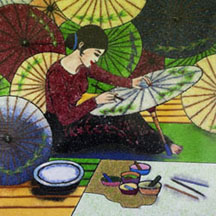Click HERE to view images from this exhibit.
 These four traditional techniques are highlighted in this exhibit.
These four traditional techniques are highlighted in this exhibit.Myanmar Gems Painting
Myanmar mosaic, a noble art, is seen mainly on royal and religious items for the purpose of enhancing their beauty and splendor. This style of painting requires the highest level of workmanship from skilled artists and uses valuable precious gems and stones with shining glorious colors. The nine noble gems are used to make these unique art pieces, fit for royals and persons of great wealth. Artists must be fully knowledgeable of this art form and give great attention to the right choice of gems and their exact placement. The finished paintings bring to others feelings of intense joy and glorious appreciation.
Lacquer Ware
Traditional lacquerware is one of the ten flowery arts and crafts of the golden land of Myanmar, and the ancient city of Bagan is its lacquerware heartland. This extraordinary fine lacquerware is made from finely cut strips of bamboo, horse hair and wood, using a mixture of lacquer resin with clay, wood sawdust and ash. Materials are carefully built-up in layers, requiring a dozen steps to complete. Finally the dried surface is polished with the ash of fossil wood. To enhance the black lacquerware, a touch of color is added by painting, or it is embellished by engraving with gold leaf. Decorative patterns and designs are created using the artists' imagination.
Myanmar Embroidery
This embroidery is elaborately designed and creatively embellished with ornaments for the purpose of grandeur. It was used in the cloth of garments worn by royalty and nobles. These tapestries are manually woven by hand using black cotton that is adorned with colored threads, colored glass beads and metallic sequins. This beautiful embroidery provides a special function. Mandalay, another ancient city, is the center of industry for this art.
Sand Painting
One art form that is found in Bagan, the ancient capital city of Myanmar, is sand painting. Local artists collect fine sand from the river and nearby streams to use in their artwork. They create their canvases by spreading acrylic glue and sprinkling sand in many layers on cotton cloth, and after drying, the artists paint their images on these sand canvases. Most of the paintings are copies of the best preserved murals found in particular temples, most dating from the 12th century. In a preservation effort, the Department of Archaeology has banned photography and making carbon copies of these murals. This, however, has not deterred local artists from making a living using these beautiful murals.

